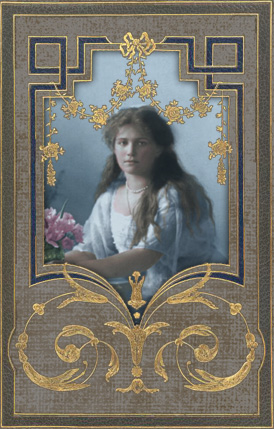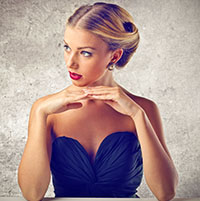Did you know that really was a profession? In 1961 you got paid $500 per letter, that would be $4100 today!







CHAPTER 2
CONCERNING THE WINTER PALACE
A DESCRIPTION of this beautiful Winter Palace may prove interesting. I have mentioned that it is the largest building in Europe; it also contains the finest staterooms. Besides these state-rooms it has fifteen hundred other rooms. The Imperial nurseries are very large, and when I explain that one of the rooms is large enough to hold a "mountain" down which the children toboggan, some idea will be given of its magnitude. This room is upholstered in red, and here the royal children are taught dancing, and are sometimes joined in their lessons by cousins or friends. The little grand duchesses already dance well and gracefully.
From this room is entered the yellow room. Here walls and furniture are covered with a yellow brocade, and here are kept the children's various toys. From this room the principal living-room is entered, which overlooks the quay and Neva, also the garden. It is very sunny and bright, and is furnished in blue. A plain velvet pile blue carpet covers the floor. The walls are covered with cornflower patterned chintz. Very sweet and charming it is. From this two bedrooms are entered. Both are upholstered with pink and green chintz, and have plain velvet pile carpets in green. In one of them hangs a copy of Josephine Swaboda's beautiful Madonna and Child.
Over the children's rooms are those of the Empress. I have spoken of her boudoir. On one side of it is the Emperor's study, the most used room in the Palace. Here the Emperor spends hours each day working hard for the advancement of the great Empire committed to his charge. This room is plainly and solidly furnished. It overlooks the garden.
On the other side of the boudoir is the Empress's bedroom. I t is also furnished in cloth from ceiling to floor. On this are displayed the holy images, and here hangs the sacred lamp which is always kept burning before the icons. Many of these pictures are illuminated in gold, and ornamented with precious stones. Some have the face simply painted and the garments all composed of precious stones. They are beautiful specimens of the goldsmiths' work, but are hardly artistic.
In this room are kept the Empress's jewels in glass cases. Many of her jewels are unique. On one occasion the Emperor gave her an ornament in the shape of a spray of tea-roses all executed in yellow diamonds. The spray consists of a full-blown rose, with four or five buds and leaves, all life-size. Her rubies and emeralds are very fine, and, of course, her diamonds are famous. The Grand Duchess Serge, sister to the Empress, is possessed of what are considered the finest sapphires in the world. Very splendid they are, both in colour and size, but the Empress has some which run them very closely.
From the bedroom we enter the yellow room. This room is crowded with lovely and artistic objects, and here are exhibited the famous Easter eggs which were at the Paris Exhibition. These are the work of Faberge, the most renowned goldsmith in Europe. Beyond this are two other reception-rooms looking on to the quay and Neva, and then comes the dining-room, with its treasures of Bohemian and cut engraved glass. Beyond the dining-room is the Malachite room, about forty feet long. The walls have beautifully painted panels, divided by Malachite pillars; the furniture is Malachite and gilt, upholstered in crimson brocade, the floor parquet and polished like a mirror. These rooms are never shown to the public.
Then come the state rooms - great lofty halls lighted by electricity. The great white ballroom holds five thousand guests easily, allowing a place for the musicians and also space for dancing; but of course at these great functions there is little dancing.
The walls of these halls are covered with gold plates and dishes, many of them with the monograms of dead and gone Emperors andd the double-headed Eagle in precious stones. Upon these dishes were presented formerly the bread and salt with which members of the Imperial family are greeted on entering a town. When an Imperial train stops at a station, a deputation of the principal persons, headed by one called the Stavosta or Elder, presents the Emperor with bread and salt. Shortly after the accession of Nicholas II., he found that the poorer villages and communities were unable to afford the expense of the gold plate, and yet could not bear to be outdone by the richer villages. He therefore issued a decree that henceforth bread and salt should be presented only on wooden or china dishes. This is very characteristic of his thought for his poorer subjects.
But to return to the Winter Palace. Another room has eight pairs of doors of tortoiseshell embellished with gold. At the end of all these great rooms is the theatre. My little charges would sit for half an hour at a time seriously looking while the attendants changed the drop scenes, and turned on the various coloured electric lights for their entertainment. This they called "going to the theatre." Beyond the theatre are the suites assigned to the various ministers and officers and their families. Returning from the theatre, but going round the other side of the Palace, we come to the Hermitage, with all its art treasures. In the picture gallery here is the finest collection of Rembrandts extant. One of these represents the visit of the Trinity to Abraham. I was one day looking at it, trying to make out what it meant, when the little Grand Duchess Olga ran up to me, and, putting her hand in mine, asked me what I was looking at. I told her; she then looked at it earnestly, and suddenly burst out laughing, exclaimed: "Oh! What a very funny picture - a man holding a leg of mutton in his hand, and carving it with a knife, and a bird sitting at the table." The bird, needless to say, was one of the angels. He is represented with his back out, and has neatly folded his blue-and-white feather wings. There are very many beautiful pictures, but I always thought the arrangement bad. They are arranged according to schools, Dutch school, etc., all together. So one gets sacred subjects mixed up with many very different pictures.
There is a great collection of Rubens' pictures, but I cannot say that I admire them much.
In the museum are many relics of Peter the Great. His turning lathe, a great deal of his carving, presses, chests, etc.; also the horse he used to ride stuffed in company with his dogs. There is a long staff showing his height. He must have been about six feet six inches. Therefore, in many respects he deserved the title of "Great," but he was exceedingly cruel. There is a goblet so constructed as to appear much less than it really is. Whenever he wished to "remove" any person he sent for him, flattered him with many kind words, and then, filling this goblet with strong wine, commanded the obnoxious person to drink it off to his health. When he had finished the contents of the goblet the victim fell dead upon the floor.
The museum also contains a splendid collection of jewelled snuff-boxes, presented to former Emperors by monarchs, ambassadors, and other great personages, jewelled watches, swords, harness, uniforms, etc. There are also some very extraordinary portraits in mosaic work, mechanical animals and birds in silver and gold. The little children loved to ramble through this museum. When the Grand Duchess Olga was quite a little child she used to wish she could live there altogether. Here and there amongst the state-rooms are pretty winter gardens. In one of them is an aviary with hundreds of canaries, which are allowed to flit amongst the palms. There are also fountains with goldfish. Catherine II. loved musical surprises in various forms, and there are writing-tables and presses, which, on being opened, play various tunes. These were a great joy to my little charges.


